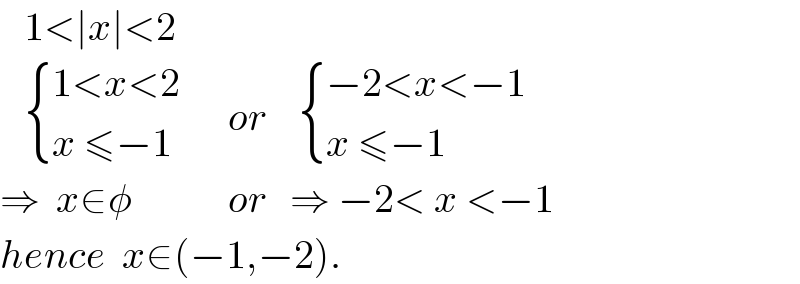
Question and Answers Forum
Question Number 63162 by Rio Michael last updated on 29/Jun/19

Commented byPrithwish sen last updated on 30/Jun/19

Commented byRio Michael last updated on 02/Jul/19

Commented bymathmax by abdo last updated on 30/Jun/19
![(e_1 ) for x≠0 and x≠1 (2/(x−1)) ≤(1/x) ⇔(2/(x−1)) −(1/x) ≤0 ⇒((2x−x+1)/(x(x−1))) ≤0 ⇒ ((x+1)/(x(x−1))) ≤0 x −∞ −1 0 1 +∞ x+1 − 0 + + + x(x−1) + + 0 − 0 + ((x+1)/(x(x−1) )) − + − + ⇒ D_1 = ]−∞ ,−1] ∪ ]0,1[ (e_2 ) x^2 −3∣x∣ +2 <0 ⇒∣x∣−3∣x∣ +2 <0 Δ =9−8 =1 ⇒ ∣x∣_1 =((3+1)/2) =2 ⇒x =+^− 2 ∣x∣_2 =((3−1)/2) =1 ⇒x =+^− 1 ⇒x^2 −3∣x∣+2 =(∣x∣−1)(∣x∣−2) (e_2 ) ⇒ (∣x∣−1)(∣x∣−2) <0 ⇒∣x∣ ∈]1,2[ ⇒ 1<∣x∣<2 1<∣x∣ ⇒x>1 or x<−1 ⇒x ∈]−∞,−1[∪]1,+∞[ ∣x∣<2 ⇒−2<x<2 ⇒ ∩ =]−2,−1[∪]1,2[ =D_2 ⇒ D =D_1 ∩D_2 =....](Q63212.png)
Answered by ajfour last updated on 30/Jun/19

